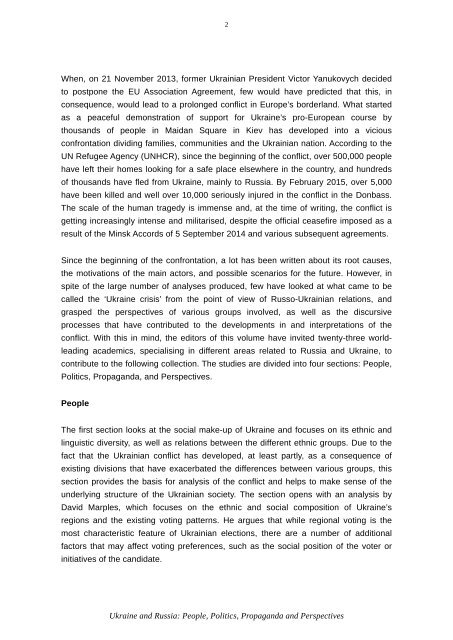Ukraine-and-Russia-E-IR
Ukraine-and-Russia-E-IR
Ukraine-and-Russia-E-IR
You also want an ePaper? Increase the reach of your titles
YUMPU automatically turns print PDFs into web optimized ePapers that Google loves.
2<br />
When, on 21 November 2013, former Ukrainian President Victor Yanukovych decided<br />
to postpone the EU Association Agreement, few would have predicted that this, in<br />
consequence, would lead to a prolonged conflict in Europe’s borderl<strong>and</strong>. What started<br />
as a peaceful demonstration of support for <strong>Ukraine</strong>’s pro-European course by<br />
thous<strong>and</strong>s of people in Maidan Square in Kiev has developed into a vicious<br />
confrontation dividing families, communities <strong>and</strong> the Ukrainian nation. According to the<br />
UN Refugee Agency (UNHCR), since the beginning of the conflict, over 500,000 people<br />
have left their homes looking for a safe place elsewhere in the country, <strong>and</strong> hundreds<br />
of thous<strong>and</strong>s have fled from <strong>Ukraine</strong>, mainly to <strong>Russia</strong>. By February 2015, over 5,000<br />
have been killed <strong>and</strong> well over 10,000 seriously injured in the conflict in the Donbass.<br />
The scale of the human tragedy is immense <strong>and</strong>, at the time of writing, the conflict is<br />
getting increasingly intense <strong>and</strong> militarised, despite the official ceasefire imposed as a<br />
result of the Minsk Accords of 5 September 2014 <strong>and</strong> various subsequent agreements.<br />
Since the beginning of the confrontation, a lot has been written about its root causes,<br />
the motivations of the main actors, <strong>and</strong> possible scenarios for the future. However, in<br />
spite of the large number of analyses produced, few have looked at what came to be<br />
called the ‘<strong>Ukraine</strong> crisis’ from the point of view of Russo-Ukrainian relations, <strong>and</strong><br />
grasped the perspectives of various groups involved, as well as the discursive<br />
processes that have contributed to the developments in <strong>and</strong> interpretations of the<br />
conflict. With this in mind, the editors of this volume have invited twenty-three worldleading<br />
academics, specialising in different areas related to <strong>Russia</strong> <strong>and</strong> <strong>Ukraine</strong>, to<br />
contribute to the following collection. The studies are divided into four sections: People,<br />
Politics, Propag<strong>and</strong>a, <strong>and</strong> Perspectives.<br />
People<br />
The first section looks at the social make-up of <strong>Ukraine</strong> <strong>and</strong> focuses on its ethnic <strong>and</strong><br />
linguistic diversity, as well as relations between the different ethnic groups. Due to the<br />
fact that the Ukrainian conflict has developed, at least partly, as a consequence of<br />
existing divisions that have exacerbated the differences between various groups, this<br />
section provides the basis for analysis of the conflict <strong>and</strong> helps to make sense of the<br />
underlying structure of the Ukrainian society. The section opens with an analysis by<br />
David Marples, which focuses on the ethnic <strong>and</strong> social composition of <strong>Ukraine</strong>’s<br />
regions <strong>and</strong> the existing voting patterns. He argues that while regional voting is the<br />
most characteristic feature of Ukrainian elections, there are a number of additional<br />
factors that may affect voting preferences, such as the social position of the voter or<br />
initiatives of the c<strong>and</strong>idate.<br />
<strong>Ukraine</strong> <strong>and</strong> <strong>Russia</strong>: People, Politics, Propag<strong>and</strong>a <strong>and</strong> Perspectives


